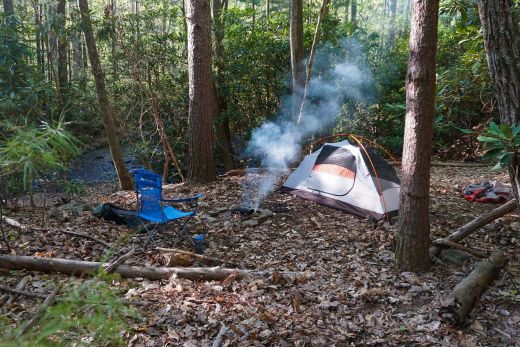Choosing a suitable campsite is an important part of any backcountry adventure. Knowing what to look for and what to avoid can mean the difference between a restful sleep and a cold, wet night fraught with angst. In this article I cover the different types of campsite, list some factors worth considering when selecting these types of sites, and explain what to look out for when choosing a dispersed or primitive campsite. With the question of ‘where’ covered, I then go on to give you a few tips for setting up a campsite that will make camp life that little bit easier and more enjoyable.
Types of campsite
Camping areas vary in the types of facilities provided, accessibility, and regulations. In North America there are roughly three types of campsite. Knowing what to expect from each is essential for planning and preparing for any outdoor trip.
Campgrounds
Campgrounds are the most common type of camping area. These sites are generally accessible by road and have amenities such as fireplaces, picnic tables, toilets, and showers. Besides wind breaks and shade, the biggest factors when choosing a campground site are neighbours (avoid raucous groups and those with small children) and the distance to amenities. You don’t want to be too close to the toilet and too far from the closest tap. Given the popularity of campground sites, it’s best to book one in advance if that’s possible.
Designated backcountry campsites
Designated backcountry sites are barebones campsites set aside to reduce the impact of campers in wilderness areas. Besides a clear space for a few tents, a backcountry site will include a fire ring and maybe an outhouse or latrine if it’s on a popular trail. Don’t expect running water or trash disposal. On maps these sites are usually marked with a tent symbol. While some parks allow campers to reserve backcountry sites ahead of time, almost all parks leave at least half of the sites to be reserved in person.
Primitive campsites
Primitive camping, wilderness camping, and dispersed camping generally mean the same thing. You hike into the wilderness and set up camp wherever you find a good spot. As the least regulated form of camping, this is both the freest type of camping and that most likely to negatively impact the environment if not practiced responsibly. Follow any park rules around dispersed camping, and if there aren’t any, follow Leave No Trace best practices. To reduce the impact of primitive camping, many parks limit sites to eight campers.
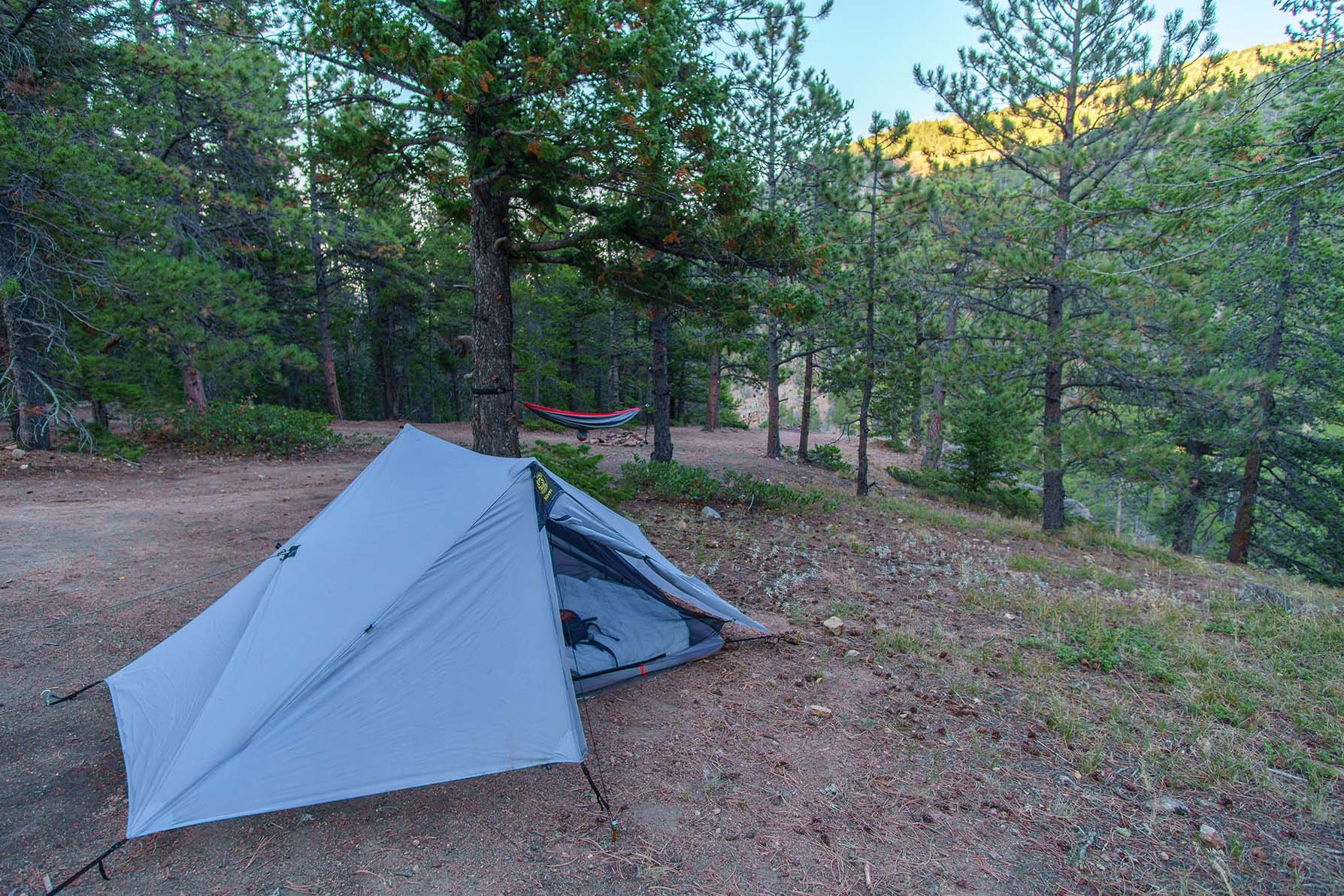
What to look for in a campsite
Campground campsites and designated backcountry campsites are chosen with the basics in mind – level, well drained, and clear of any hazards – and you’ll only have to decide whether you want a view, windbreak or breeze. Primitive campsites, on the other hand, can be anywhere, and you’ll need to put more thought into choosing the best spot to ensure a safe and comfortable site.
Elevation
Low lying areas collect cold air from katabatic winds, and it’s best to avoid valley floors where the air will be colder and the dew and frost will be greater. Valley floors also pose a higher risk of flooding and take longer to dry out and warm up after rain.
A safe distance from water
You want to be a short walk from a water source but also not too close. Bugs breed in slow moving water, and any water source can attract animals. To mitigate risk, select a site 200 to 1000 feet from a lake or stream. If you have to camp closer than that, ensure your site isn’t in a path that might be used by animals.
Off trail
Look for a spot off-trail so that your camp doesn’t affect other people’s wilderness experience. It’s best to also adhere to Leave No Trace principles and camp only on durable surfaces – those that are naturally hard or have already been compacted.
Level and well drained
You don’t want to wake up in a puddle or spend the night trying to stay on your sleeping pad. The ideal spot is flat and with the ground sloping gently away on either side of it. If the ground is very flat, you can dig a trench around your tarp to divert any water run-off away from your sleeping area.
Breezy or protected by a windbreak
Depending on conditions, you might want to shelter from the wind or expose yourself to a breeze to keep bugs away. This decision can be particularly important when tarp camping. A breeze will help keep the bugs off you, while a wind break will stop rain from coming at you sideways.
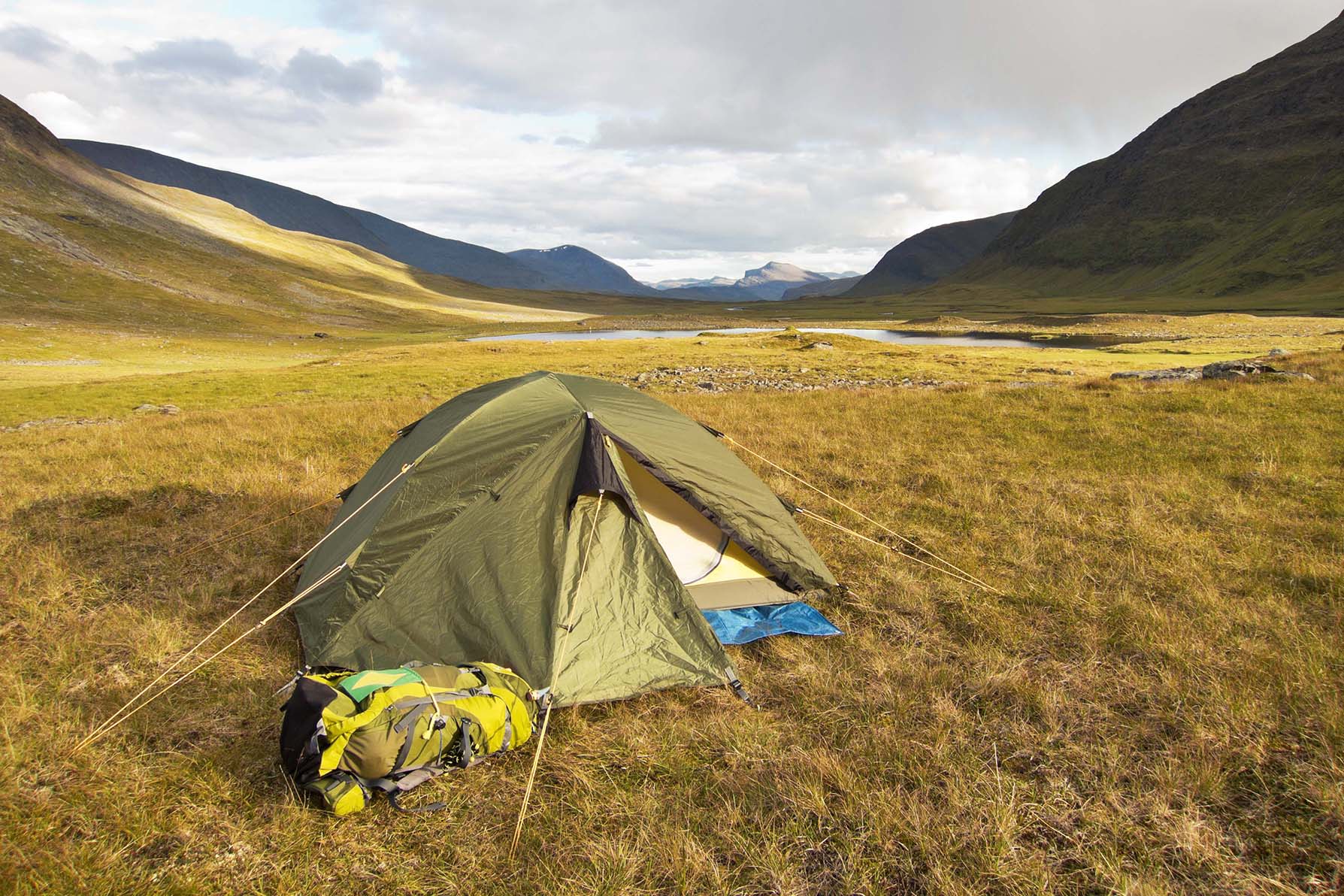
When using dispersed or primitive campsites, it helps to break the campsite selection process into two steps. First look at a map and identify a good area to camp in. On a good topographical map, you’ll be able to identify water sources, valley bottoms, steep slopes, and marshy areas. Once you’ve reached your chosen area, you can then look for a spot with level, compact and well drained ground, and maybe a windbreak and view if you need those.
What to avoid
Besides knowing what to look for in a campsite, you also want to know what to avoid. You don’t want to wake up to find your gear floating out of your tent or face-off with a grizzly as it goes through your pack.
Areas frequented by scavengers
If you know there are animals in the area, you should take measures to stop them from finding your food. But you also don’t want to pitch your camp on a trail used by animals, especially if it marks a route to water or possible den.
Flood plains
Gorges and flood plains are not great places to camp for obvious reasons. Always try to make camp above flood level – look for debris that marks the last highpoint . If you have to camp in a watershed, pay careful attention to any changes in weather patterns. If there is a chance of rain, it is best to keep walking and make camp elsewhere.
Exposed ridges
Avoid camping on exposed ridges or hilltops, especially in areas that experience frequent storms. If conditions are bad, it is usually better to descend and look for shelter in wooded areas – but away from trees or branches that might come down in high winds – or in the lee of boulders.
Lone trees
Lone trees can attract lightning strikes. So, while a lone pine might offer the only shade on a high plain, know that it also acts as a giant conductor. In areas susceptible to electric storms, it would be best to camp elsewhere, ideally on lower ground. For more advice on lightning safety, see my article How to avoid a lightning strike.
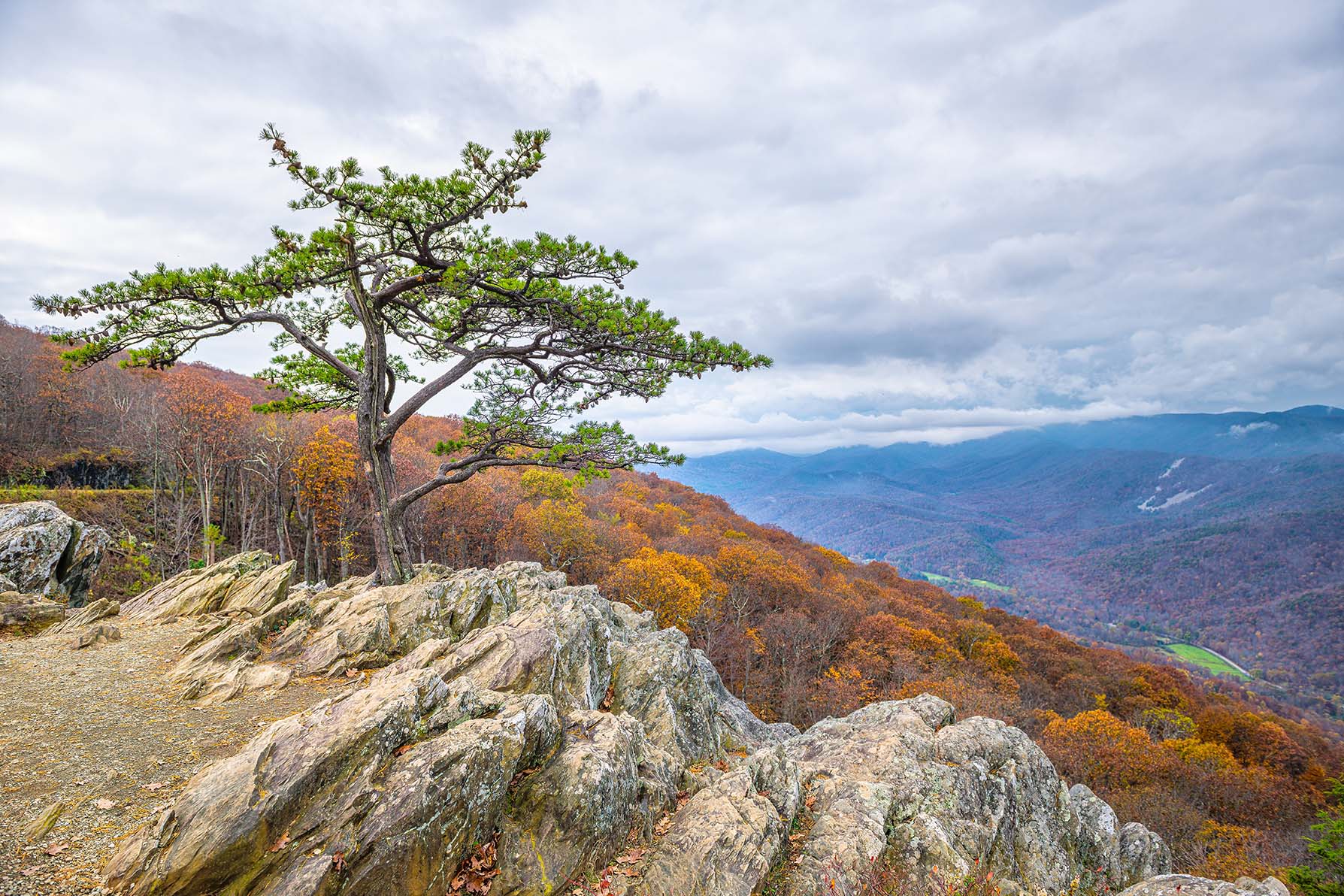
Tips for setting up camp
After you have found the perfect spot, there are still a few things you can do to make camp life easier or less hazardous.
Give careful thought to wind direction
The best way to pitch your shelter relative to the wind will differ from situation to situation. Upwind from your fire is always better than downwind, but you then might have to decide whether you want your tent or tarp sheltered in the lee of a windbreak or exposed to a breeze to ward off bugs. And if you are tarp camping, how can you position your tent so that the wind doesn’t drive rain through the open entrance?
Position guylines where you won’t trip over them
Stumbling around in the dark while trying to find the latrine is hazardous enough without you setting booby traps with poorly positioned guy lines. Always assess the position of your tent or tarp before setting it up, taking care not to rig guylines across thoroughfares. As an added precaution, you can also use bright or reflective guy lines to make them easier to spot.
Scavenger-proof your food stores
Rodents are cute right up until they chew their way into your food. Take precautions against these furry little thieves by putting your food in odor-proof bags like those made by Opsak and hanging your food out of reach. In bear country, you’ll have to take additional precautions and put your food in a bear canister or, at the very least, a bear bag. Hanging your food isn’t a great way to protect it from an animal adept at climbing, but there are a few things you can do to deter these apex scavengers.
Know where you are going to poop
Trying to find the latrine or a place to poop in the wee hours of the morning is never fun. You can make it easier to answer nature’s call by locating the latrine the day before or, if you have to dig a cat hole, do this well in advance. It also helps to put your TP and sanitiser where they will be easy to find when you need them.
Leave No Trace
You should always aim to leave no trace, but LNT practices become even more important when you use primitive campsites. In addition to ensuring that you leave no trash behind, you should avoid making fires (except in emergencies) and disturbing vegetation to make space for your shelter. When it’s time to leave, make sure to eliminate all signs of your camp including any imprint your tent might have left.
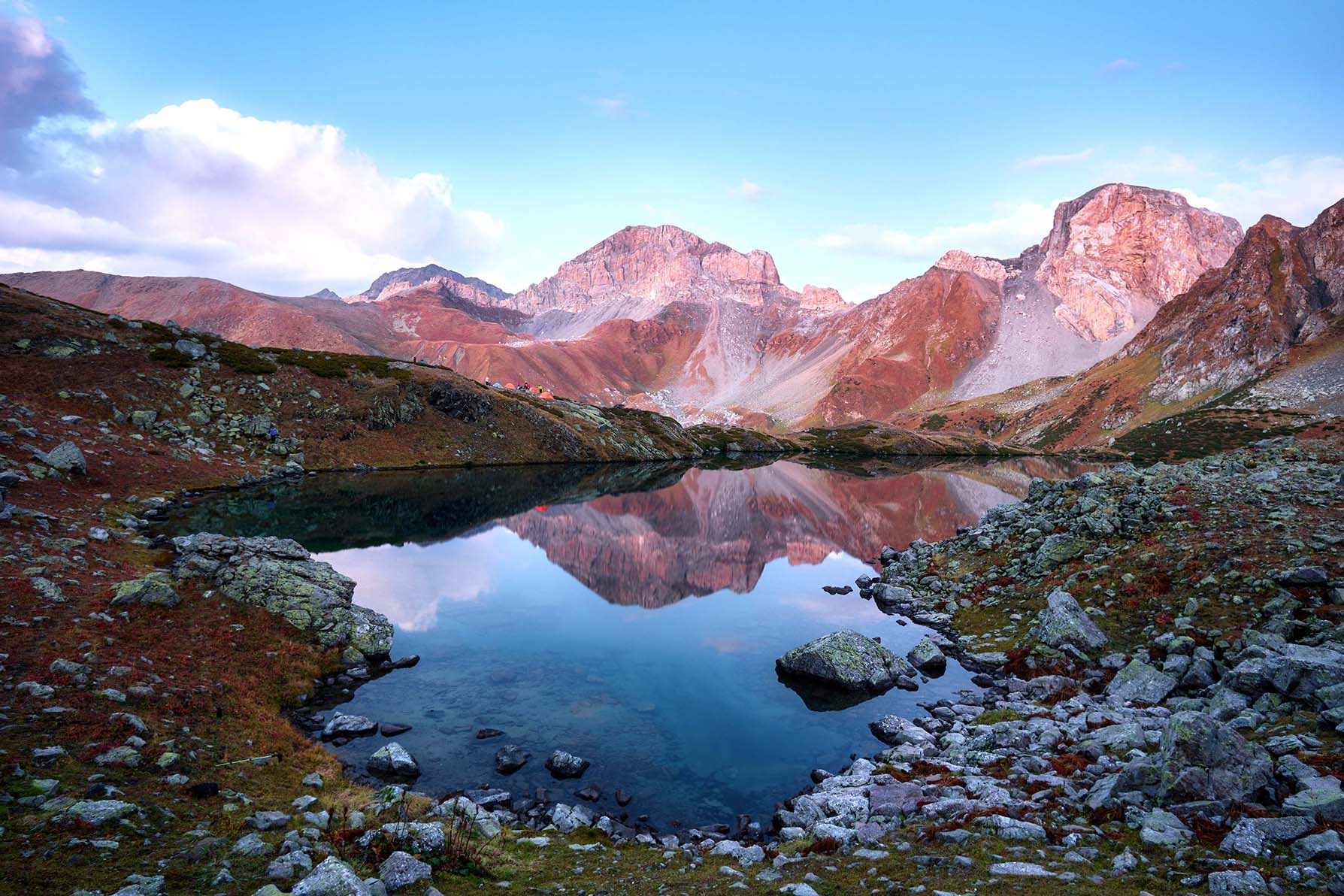
Get out there
The best way to hone your camping skills is to get out there and practice them. With time and experience, you’ll learn how to identify suitable sites and how to set up a camp that makes life on the trail just that much more enjoyable. But if it’s more useful information that you’re after, this site is filled with articles on everything from backcountry cooking to survival skills, making this an indispensable resource for anyone who wants to acquire new outdoor skills.
